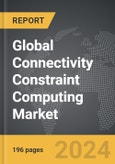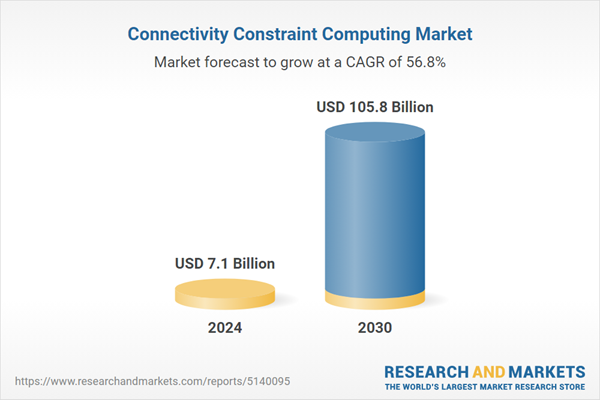The global market for Connectivity Constraint Computing was valued at USD 7.1 Billion in 2024 and is projected to reach USD 105.8 Billion by 2030, growing at a CAGR of 56.8% from 2024 to 2030. This comprehensive report provides an in-depth analysis of market trends, drivers, and forecasts, helping you make informed business decisions.
Global Connectivity Constraint Computing Market - Key Trends & Drivers Summarized
How Is Connectivity Constraint Computing Changing The Technological Landscape?
Connectivity Constraint Computing (CCC) is reshaping the technological landscape, especially in areas with limited or unreliable network connectivity. This emerging field focuses on optimizing computing resources and software to function effectively under constrained network conditions, making it vital for applications in remote and rural areas, disaster recovery scenarios, and edge computing environments. CCC enables local data processing, storage, and computation, reducing the dependency on consistent network availability and improving response times for critical applications. With the exponential growth of IoT devices and edge computing, the demand for CCC is increasing, particularly in sectors like healthcare, agriculture, logistics, and autonomous vehicles, where uninterrupted data processing is crucial. The ability to ensure that devices and applications continue functioning optimally despite network limitations is positioning CCC as a cornerstone technology in future digital infrastructure planning.What Innovations Are Pushing The Boundaries Of Connectivity Constraint Computing?
Innovations in hardware and software are pivotal in advancing Connectivity Constraint Computing. On the hardware side, the development of low-power, high-performance processors is enabling edge devices to handle more complex computations locally without relying heavily on cloud-based servers. Software innovations, such as lightweight machine learning algorithms and compression techniques, are ensuring that data can be processed, analyzed, and transmitted efficiently, even with minimal connectivity. Additionally, advancements in distributed computing models are facilitating better resource allocation and task distribution across devices in connectivity-constrained environments. Blockchain and decentralized technologies are also being explored to enhance data integrity and security without the need for a constant network connection. These technological advancements are essential for supporting the growing demand for connectivity constraint solutions, especially in sectors that require real-time decision-making capabilities without relying on always-on network infrastructure.How Are Key Industries Adapting To The Needs Of Connectivity Constraint Computing?
Key industries such as healthcare, automotive, agriculture, and logistics are rapidly adapting to the needs of Connectivity Constraint Computing. In healthcare, CCC is being integrated into telemedicine and remote monitoring systems to provide continuous patient care even in areas with poor network coverage. The automotive industry, particularly in the development of autonomous vehicles, relies heavily on CCC for ensuring real-time data processing and decision-making without the need for constant cloud connectivity. Similarly, in precision agriculture, CCC allows for the local processing of data from sensors and drones to optimize farming practices in remote areas with limited internet access. In logistics, CCC is improving supply chain efficiency by enabling real-time tracking and management of goods, even when connectivity is sporadic. The widespread adoption of CCC across these industries highlights its growing importance in creating robust and resilient digital infrastructures.What Factors Are Driving The Growth Of The Connectivity Constraint Computing Market?
The growth in the Connectivity Constraint Computing market is driven by several factors, including the rising adoption of IoT devices, the expansion of edge computing, and the increasing need for real-time data processing in remote and underserved areas. One of the main drivers is the proliferation of IoT and edge devices, which require reliable, low-latency computing capabilities despite network constraints. The push towards digital transformation across industries is also fueling demand, as organizations seek to enhance operational efficiency and service delivery through robust connectivity solutions. Moreover, the growing emphasis on data privacy and security is prompting companies to adopt CCC solutions that minimize data transmission over public networks. The development of smart cities and connected infrastructure further accelerates the need for CCC to manage data efficiently across diverse environments. These factors, along with ongoing technological innovations, are propelling the market's growth trajectory.Report Scope
The report analyzes the Connectivity Constraint Computing market, presented in terms of market value (USD Thousand). The analysis covers the key segments and geographic regions outlined below.Segments
Application (Ecosystem & Healthcare Management System, Public Health Surveillance).Geographic Regions/Countries
World; United States; Canada; Japan; China; Europe (France; Germany; Italy; United Kingdom; and Rest of Europe); Asia-Pacific; Rest of World.Key Insights:
- Market Growth: Understand the significant growth trajectory of the Ecosystem & Healthcare Management System Application segment, which is expected to reach $44.9 Billion by 2030 with a CAGR of a 45.5%. The Public Health Surveillance Application segment is also set to grow at 71.5% CAGR over the analysis period.
- Regional Analysis: Gain insights into the U.S. market, valued at $2.1 Billion in 2024, and China, forecasted to grow at an impressive 53% CAGR to reach $14.1 Billion by 2030. Discover growth trends in other key regions, including Japan, Canada, Germany, and the Asia-Pacific.
Report Features:
- Comprehensive Market Data: Independent analysis of annual sales and market forecasts in USD from 2024 to 2030.
- In-Depth Regional Analysis: Detailed insights into key markets, including the U.S., China, Japan, Canada, Europe, Asia-Pacific, Latin America, Middle East, and Africa.
- Company Profiles: Coverage of major players such as Amazon.com, Inc., Cognizant Technology Solutions Corporation, Google, Inc., IBM Corporation, Microsoft Corporation and more.
- Complimentary Updates: Receive free report updates for one year to keep you informed of the latest market developments.
Why You Should Buy This Report:
- Detailed Market Analysis: Access a thorough analysis of the Global Connectivity Constraint Computing Market, covering all major geographic regions and market segments.
- Competitive Insights: Get an overview of the competitive landscape, including the market presence of major players across different geographies.
- Future Trends and Drivers: Understand the key trends and drivers shaping the future of the Global Connectivity Constraint Computing Market.
- Actionable Insights: Benefit from actionable insights that can help you identify new revenue opportunities and make strategic business decisions.
Key Questions Answered:
- How is the Global Connectivity Constraint Computing Market expected to evolve by 2030?
- What are the main drivers and restraints affecting the market?
- Which market segments will grow the most over the forecast period?
- How will market shares for different regions and segments change by 2030?
- Who are the leading players in the market, and what are their prospects?
Some of the 46 major companies featured in this Connectivity Constraint Computing market report include:
- Amazon.com, Inc.
- Cognizant Technology Solutions Corporation
- Google, Inc.
- IBM Corporation
- Microsoft Corporation
- Oracle Corporation
- Tata Consultancy Services Ltd.
- Wal-Mart Stores, Inc.
Table of Contents
I. METHODOLOGYII. EXECUTIVE SUMMARY2. FOCUS ON SELECT PLAYERSIII. MARKET ANALYSISIV. COMPETITION
1. MARKET OVERVIEW
3. MARKET TRENDS & DRIVERS
4. GLOBAL MARKET PERSPECTIVE
UNITED STATES
CANADA
JAPAN
CHINA
EUROPE
FRANCE
GERMANY
ITALY
UNITED KINGDOM
REST OF EUROPE
ASIA-PACIFIC
REST OF WORLD
Companies Mentioned (Partial List)
A selection of companies mentioned in this report includes, but is not limited to:
- Amazon.com, Inc.
- Cognizant Technology Solutions Corporation
- Google, Inc.
- IBM Corporation
- Microsoft Corporation
- Oracle Corporation
- Tata Consultancy Services Ltd.
- Wal-Mart Stores, Inc.
Table Information
| Report Attribute | Details |
|---|---|
| No. of Pages | 196 |
| Published | April 2025 |
| Forecast Period | 2024 - 2030 |
| Estimated Market Value ( USD | $ 7.1 Billion |
| Forecasted Market Value ( USD | $ 105.8 Billion |
| Compound Annual Growth Rate | 56.8% |
| Regions Covered | Global |









